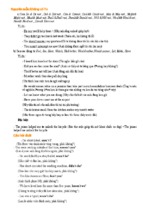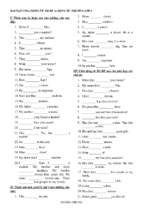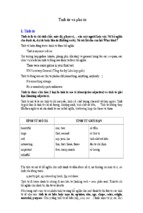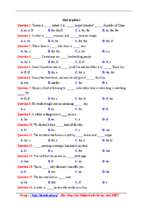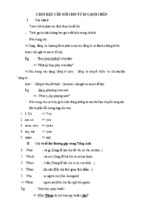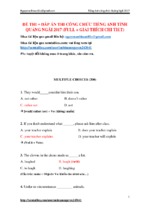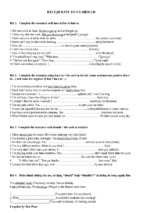Mô tả:
visit the link to get test
Website : https://1001dethi.com/ dt 0909265875 .thầy phúc
SÁCH STARTERS :
Cụ thể : 1 bộ sách Starters 9 cuốn +audio listening
Trọn gói : 50.000Đ.
SÁCH MOVERS :
Cụ thể : 1 bộ sách Movers 9 cuốn + audio listening
Trọn gói : 50.000Đ.
SÁCH FLYERS :
Cụ thể : 1 bộ sách Flyers 9 cuốn +audio listening
Trọn gói : 50.000Đ
SÁCH KET :
Cụ thể : 1 bộ sách KET 10 cuốn +audio listening
Trọn gói : 50.000Đ
SÁCH PET :
Cụ thể : 1 bộ sách PET 8 cuốn +audio listening
Trọn gói : 40.000Đ
SÁCH Longman New Real Toeic (Trọn bộ 3 cuốn RC,LC và Full)
Trọn gói : 30.000Đ
DEVELOPING
LISTENING SKILLS I
FEBRUARY 2009
ORLANDO CARRANZA
OUTLINE
THE IMPORTANCE OF LISTENING
WHAT MAKES LISTENING DIFFICULT?
LISTENING STAGES
PSYCHOLOGICAL PROCESSES: BOTTOM–UP AND TOP–DOWN
STRATEGIES RELATED TO BOTTOM–UP PROCESSING
- Listening for specific details
- Recognizing Cognates
- Recognizing word order patterns
STRATEGIES RELATED TO TOP–DOWN PROCESSING
- Listening for the main idea
- Predicting
- Drawing inferences
- Summarizing
THE IMPORTANCE OF LISTENING
Language learning depends on Listening.
Speaking does not constitute communication by itself unless what
is said is comprehended by another person.
Listening is used far more than any other single language skill in
normal daily life.
WHAT MAKES LISTENING DIFFICULT?
CLUSTERING. Learners try to retain a long sentence or
several sentences at a time or try to understand
every word in an utterance.
REDUNDANCY. Learners have to understand that not
every sentence contains new information, and
they must be aware of the signals of redundancy.
REDUCED FORMS. Spoken language contains a good deal
of reduced forms that pose significant difficulties for the
learner.
PERFORMANCE VARIABLES. Hesitations, false starts,
pauses and corrections can easily interfere with
comprehension in second language learners.
WHAT MAKES LISTENING
DIFFICULT?
COLLOQUIAL LANGUAGE. Language learners find difficult to deal
with colloquial language like, idioms, slang, contractions and
assimilations.
RATE OF DELIVERY. Learners will need to be able to understand
language delivered at different rates of speed.
STRESS, RHYTHM AND INTONATION. Intonation patterns are very
significant not just for interpreting questions or statements but also
to get more subtle messages like sarcasm, insult, praise, etc.
INTERACTION. This will play a large role in listening comprehension
because the students have to continue a chain of listening and
responding.
LISTENING STAGES
Because of the uncertainties that language learners experience when listening,
it is usually necessary to design activities following these stages:
THE PRE-LISTENING STAGE.
Activities the teacher has to do before the students actually listen to
the audio. One important objective is to contextualize the text
providing learners information about the setting and the role
relationships between participants.
WHILE-LISTENING STAGE.
The work at this stage needs to link in relevant ways to the prelistening work. The purpose is to help the learner develop the skill of
eliciting messages from spoken language.
POST-LISTENING STAGE.
They allow the learners to “reflect", reinforce and use the language
presented on the task.
BOTTOM-UP AND
TOP-DOWN PROCESSES
The bottom-up mode of language processing involves
the listener paying close attention to every detail of the
language input. The understanding of the language is
worked out from sounds to words to grammatical
relationships to lexical meanings, etc., to a “final”
message.
The top-down process of listening involves the
listener’s ability to bring prior information to the task of
understanding the “heard” language. It is concerned
with the activation of schemata, with deriving meaning,
with global understanding, and with the interpretation of
a text.
EXAMPLES
WHAT ARE THE PROCESSES THE PERSONS ARE USING IN EACH EXAMPLE?
1.
2.
3.
4.
Joe is listening casually to people talking in a birthday
party.
A friend calls you to invite you to a party at her house
the following Saturday. As you’ve never been to her
house before, she gives you directions. You listen
carefully and take notes.
A person has to listen closely to a joke in order to know
when to laugh.
While having lunch, a friend tells you a story about a
recent holiday, which was a disaster for him. You listen
and make some comments just to express some concern
or sympathy.
STRATEGIES
STRATEGIES RELATED TO BOTTOM – UP PROCESSING
LISTENING FOR SPECIFIC DETAILS
RECOGNIZING COGNATES
RECOGNIZING WORD ORDER PATTERNS
STRATEGIES RELATED TO TOP – DOWN PROCESSING
LISTENING FOR THE MAIN IDEA
PREDICTING
DRAWING INFERENCES
SUMMARIZING
REFERENCES
Morley, J. (2001). U11A Listening Skills. In Celce-Murcia (Ed.),
Teaching English as a Second or Foreign Language (pp.74-75).
Heinle & Heinle
Harmer, J. (1998). How to Teach English. Longman
Brown, H.D. (2007). Teaching by Principles: an Interactive Approach
to Language Pedagogy. Pearson Education
Hedge, T. (2000). Teaching and Learning in the Language Classroom.
Oxford University Press
Listening: Top-down and bottom-up
http://www.teachingenglish.org.uk/think/articles
Morley,
C.
(2007)
NCLRC The Essentials of Language Teaching(2004):
Strategies for Developing Listening Skills in
http://www.nclrc.org/essentials/listening/stratlisten.htm
in
Orlando Carranza
ICPNA
ETECS
- Xem thêm -

